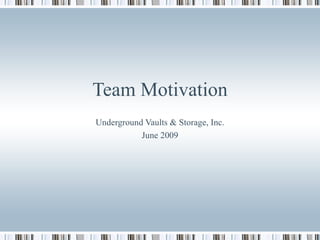Motivating Your Team
•Descargar como PPT, PDF•
2 recomendaciones•10,843 vistas
Denunciar
Compartir
Denunciar
Compartir

Recomendados
Más contenido relacionado
La actualidad más candente
La actualidad más candente (20)
Coaching Skills for Your Managers and Leaders - Webinar 10.21.14

Coaching Skills for Your Managers and Leaders - Webinar 10.21.14
Most Effective Team Building Training - Tonex Training

Most Effective Team Building Training - Tonex Training
For An Effective Team Building Practice You Should Know..

For An Effective Team Building Practice You Should Know..
Destacado
Destacado (20)
Team Building PowerPoint PPT Content Modern Sample

Team Building PowerPoint PPT Content Modern Sample
Motivating Inspiringly Presentation Eye Belgium 20090530

Motivating Inspiringly Presentation Eye Belgium 20090530
Ebook it's all about strategy execution - new edition

Ebook it's all about strategy execution - new edition
Similar a Motivating Your Team
Similar a Motivating Your Team (20)
Team leadership and motivationTeam leadership and mo.docx

Team leadership and motivationTeam leadership and mo.docx
Transformational Leadership: Inspiring Motivation Utilizing Advances in Posit...

Transformational Leadership: Inspiring Motivation Utilizing Advances in Posit...
Más de Jennifer Coker
Más de Jennifer Coker (19)
Último
unwanted pregnancy Kit [+918133066128] Abortion Pills IN Dubai UAE Abudhabi![unwanted pregnancy Kit [+918133066128] Abortion Pills IN Dubai UAE Abudhabi](data:image/gif;base64,R0lGODlhAQABAIAAAAAAAP///yH5BAEAAAAALAAAAAABAAEAAAIBRAA7)
![unwanted pregnancy Kit [+918133066128] Abortion Pills IN Dubai UAE Abudhabi](data:image/gif;base64,R0lGODlhAQABAIAAAAAAAP///yH5BAEAAAAALAAAAAABAAEAAAIBRAA7)
unwanted pregnancy Kit [+918133066128] Abortion Pills IN Dubai UAE AbudhabiAbortion pills in Kuwait Cytotec pills in Kuwait
Último (20)
Insurers' journeys to build a mastery in the IoT usage

Insurers' journeys to build a mastery in the IoT usage
VIP Call Girls Gandi Maisamma ( Hyderabad ) Phone 8250192130 | ₹5k To 25k Wit...

VIP Call Girls Gandi Maisamma ( Hyderabad ) Phone 8250192130 | ₹5k To 25k Wit...
Understanding the Pakistan Budgeting Process: Basics and Key Insights

Understanding the Pakistan Budgeting Process: Basics and Key Insights
Enhancing and Restoring Safety & Quality Cultures - Dave Litwiller - May 2024...

Enhancing and Restoring Safety & Quality Cultures - Dave Litwiller - May 2024...
Yaroslav Rozhankivskyy: Три складові і три передумови максимальної продуктивн...

Yaroslav Rozhankivskyy: Три складові і три передумови максимальної продуктивн...
RSA Conference Exhibitor List 2024 - Exhibitors Data

RSA Conference Exhibitor List 2024 - Exhibitors Data
KYC-Verified Accounts: Helping Companies Handle Challenging Regulatory Enviro...

KYC-Verified Accounts: Helping Companies Handle Challenging Regulatory Enviro...
unwanted pregnancy Kit [+918133066128] Abortion Pills IN Dubai UAE Abudhabi![unwanted pregnancy Kit [+918133066128] Abortion Pills IN Dubai UAE Abudhabi](data:image/gif;base64,R0lGODlhAQABAIAAAAAAAP///yH5BAEAAAAALAAAAAABAAEAAAIBRAA7)
![unwanted pregnancy Kit [+918133066128] Abortion Pills IN Dubai UAE Abudhabi](data:image/gif;base64,R0lGODlhAQABAIAAAAAAAP///yH5BAEAAAAALAAAAAABAAEAAAIBRAA7)
unwanted pregnancy Kit [+918133066128] Abortion Pills IN Dubai UAE Abudhabi
Value Proposition canvas- Customer needs and pains

Value Proposition canvas- Customer needs and pains
Regression analysis: Simple Linear Regression Multiple Linear Regression

Regression analysis: Simple Linear Regression Multiple Linear Regression
Call Girls Jp Nagar Just Call 👗 7737669865 👗 Top Class Call Girl Service Bang...

Call Girls Jp Nagar Just Call 👗 7737669865 👗 Top Class Call Girl Service Bang...
The Path to Product Excellence: Avoiding Common Pitfalls and Enhancing Commun...

The Path to Product Excellence: Avoiding Common Pitfalls and Enhancing Commun...
B.COM Unit – 4 ( CORPORATE SOCIAL RESPONSIBILITY ( CSR ).pptx

B.COM Unit – 4 ( CORPORATE SOCIAL RESPONSIBILITY ( CSR ).pptx
Motivating Your Team
- 1. Team Motivation Underground Vaults & Storage, Inc. June 2009
- 5. Maslow’s Hierarchy of Needs
- 6. McGregor’s Factor X/Y Theory Management Staff Staff Management Theory X - authoritarian, repressive style. Tight control, no development. Produces limited, depressed culture Theory Y - liberating and developmental. Control, achievement and continuous improvement achieved by enabling, empowering and giving responsibility.
- 7. Herzberg’s Motivation and Hygiene Theory
Notas del editor
- Today we are going to look at 5 studies on motivation that created “theories” concerning the psychology of motivation. From each study we will determine how it applies to our workplace and how we can apply it to our employees. Through filling out worksheets and considering these theories, we should all be able to walk away thinking differently about motivation and how we can affect our teams.
- By creating an appealing and motivating work environment, you significantly increase the likelihood that your people will work hard for you. “setting the stage for excellent performance”
- After discussing the pyramid – the base 3 levels should be reinforced by our environment while the top two are needs we work to meet – fill out worksheet on how UV&S currently meets the levels of need and how we could better meet those needs going forward.
- theory x ('authoritarian management' style) The average person dislikes work and will avoid it he/she can. Therefore most people must be forced with the threat of punishment to work towards organisational objectives. The average person prefers to be directed; to avoid responsibility; is relatively unambitious, and wants security above all else. theory y ('participative management' style) Effort in work is as natural as work and play. People will apply self-control and self-direction in the pursuit of organizational objectives, without external control or the threat of punishment. Commitment to objectives is a function of rewards associated with their achievement. People usually accept and often seek responsibility. The capacity to use a high degree of imagination, ingenuity and creativity in solving organizational problems is widely, not narrowly, distributed in the population. In industry the intellectual potential of the average person is only partly utilized. At this time, take quiz to see what style you are and what style you prefer.
- Eliminate dissatisfactions and create areas of satisfaction with hygiene factors to free up ability to be motivated
